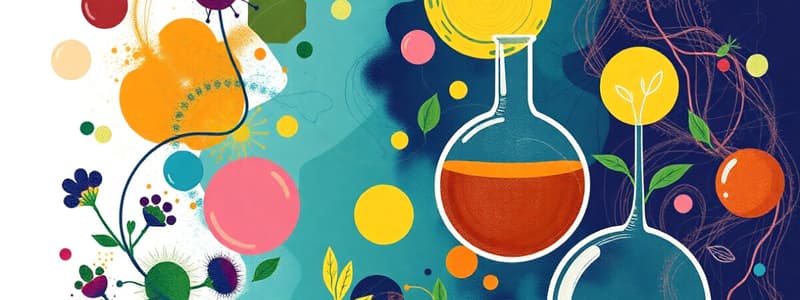Podcast
Questions and Answers
What is the broad definition of biotechnology?
What is the broad definition of biotechnology?
Biotechnology is a broad area of biology involving the use of living systems and organisms to develop or make products.
Name three fields where biotechnology is commonly applied.
Name three fields where biotechnology is commonly applied.
Agriculture, food science, and medicine.
What natural process has been used for centuries involving microorganisms to produce food?
What natural process has been used for centuries involving microorganisms to produce food?
Fermentation.
Name three food items that are produced using fermentation.
Name three food items that are produced using fermentation.
What is the basic process of fermentation with respect to glucose?
What is the basic process of fermentation with respect to glucose?
Name two reasons for the increase in the use of biotechnology by the food industry.
Name two reasons for the increase in the use of biotechnology by the food industry.
Give one example of how the fermentation process can preserve food.
Give one example of how the fermentation process can preserve food.
How can fermentation change the nutritional value of food products?
How can fermentation change the nutritional value of food products?
What aspect of food can fermentation improve?
What aspect of food can fermentation improve?
What is the emphasis of modern biotechnology focused on?
What is the emphasis of modern biotechnology focused on?
What types of organisms are modified using modern biotechnology?
What types of organisms are modified using modern biotechnology?
Which type of organism has been the primary focus of modern biotechnology efforts?
Which type of organism has been the primary focus of modern biotechnology efforts?
Define 'synthetic biology'.
Define 'synthetic biology'.
What is the pioneer of synthetic biology?
What is the pioneer of synthetic biology?
List two characteristics of genetic engineering.
List two characteristics of genetic engineering.
What is another name for genetic engineering?
What is another name for genetic engineering?
Name 3 applications of biotechnology.
Name 3 applications of biotechnology.
What is Red Biotechnology concerned with?
What is Red Biotechnology concerned with?
Define White biotechnology.
Define White biotechnology.
Describe what Green biotechnology is?
Describe what Green biotechnology is?
What does Blue biotechnology deal with?
What does Blue biotechnology deal with?
Name some products that are made with White Biotechnology.
Name some products that are made with White Biotechnology.
What are the four 'pillars' of biotechnology.
What are the four 'pillars' of biotechnology.
Explain the role of regulations in the context of the 'pillars of biotechnology'.
Explain the role of regulations in the context of the 'pillars of biotechnology'.
Describe the relationship between 'bioinformatics' and 'blue biotechnology'.
Describe the relationship between 'bioinformatics' and 'blue biotechnology'.
Flashcards
What is biotechnology?
What is biotechnology?
Biotechnology is a broad field using living systems and organisms to create products.
Traditional Biotechnology
Traditional Biotechnology
Traditional biotechnology is mainly for producing foods like cheese, bread, and yogurt using fermentation.
Fermentation Process Benefits
Fermentation Process Benefits
Fermentation preserves food, changes nutritional value and enhances flavor/texture.
Modern Biotechnology
Modern Biotechnology
Signup and view all the flashcards
Synthetic Biology
Synthetic Biology
Signup and view all the flashcards
Genetic Engineering
Genetic Engineering
Signup and view all the flashcards
rDNA technology
rDNA technology
Signup and view all the flashcards
Transgenic Organisms
Transgenic Organisms
Signup and view all the flashcards
Medical Biotechnology
Medical Biotechnology
Signup and view all the flashcards
Applications of Medical Biotech
Applications of Medical Biotech
Signup and view all the flashcards
Medical Biotechnology Focus
Medical Biotechnology Focus
Signup and view all the flashcards
DNA Fingerprinting
DNA Fingerprinting
Signup and view all the flashcards
Red Biotechnology
Red Biotechnology
Signup and view all the flashcards
Fields in Biotech Applications
Fields in Biotech Applications
Signup and view all the flashcards
White Biotechnology
White Biotechnology
Signup and view all the flashcards
Industrial Biotechnology Benefit
Industrial Biotechnology Benefit
Signup and view all the flashcards
Green Biotechnology
Green Biotechnology
Signup and view all the flashcards
Agricultural Biotech - Uses
Agricultural Biotech - Uses
Signup and view all the flashcards
Uses of Health Care Biotech
Uses of Health Care Biotech
Signup and view all the flashcards
Preventing environmental problems
Preventing environmental problems
Signup and view all the flashcards
Applications -Enzymes
Applications -Enzymes
Signup and view all the flashcards
Blue Biotechnology
Blue Biotechnology
Signup and view all the flashcards
Blue BIotech Applications
Blue BIotech Applications
Signup and view all the flashcards
Biotechnology - Key aspects
Biotechnology - Key aspects
Signup and view all the flashcards
Uses for White/Industrial Biotechnology
Uses for White/Industrial Biotechnology
Signup and view all the flashcards
Study Notes
- Biotechnology is a broad field of biology that uses living systems and organisms to develop or create products.
- Biotechnology is a technology using living organisms for human benefit and other life forms.
- Biotechnology is primarily used in agriculture, food science, and medicine, where organisms are used to create chemicals and products or perform industrial tasks.
Biotechnology History
- Fermentation has been used for centuries with microorganisms like yeast and bacteria to produce beer, bread, yogurt, and cheese.
- Bread making, beer brewing, and pickling use naturally occurring microorganisms for food and drink production.
- Fermentation converts glucose (sugar) into alcohol and carbon dioxide or lactic acid via enzymes.
Biotechnology Increases
- Rising biotechnology use in the food industry is influenced by market competition.
- There are attempts to increase efficiency and reduce the environmental impact of production.
- Biotechnology use is driven by consumer demand for convenient, high-quality products at reasonable costs.
Traditional Biotechnology
- Traditional biotechnology mainly involves producing foods like cheese, bread, yogurt, and wine.
- Fermentation Process
- Preservation method: acid production lowers pH, extending shelf life of perishable foods.
- Allows for changes to the nutritional value of food products; converting milk to cheese
- Sensory improvements to foods through flavour, aroma, and texture.
Modern Biotechnology
- Modern biotechnology emphasizes raw material and food ingredient production.
- Focuses on changing the characteristics of plants, animals, and microorganisms, including fungi.
- Work has primarily been conducted in plants to date.
Emerging Technologies
- A prominent emerging technology is "synthetic biology," described as "the engineer's approach to biology."
- Genetic engineering is considered the pioneer of synthetic biology.
- Nanotechnology was marked by the 1986 publication of "Engines of Creation".
- Information technology includes the 1958 invention of the microchip and the 1947 invention of the transistor.
- Molecular biology refers to the 1953 discovery of DNA.
- Developments in gene technology include the first genetically modified organism (E. coli) in 1972.
- Genomics includes the publication of the Human Genome in 2001.
Genetic Engineering
- Genetic engineering inserts DNA fragments into the chromosomes of cells.
- It uses tissue culture to regenerate cells into a whole organism with a different genetic composition.
- Genetic engineering is also known as rDNA technology.
- Transgenic organisms are a product of genetic engineering.
Biotechnology Applications
- Biotechnology has applications in the food, pharmaceutical, and agricultural industries.
- Medical biotechnology fields include diagnostics, therapeutics, and vaccines.
- Agricultural biotechnology involves plant agriculture and farms, and food processing.
- Industrial biotechnology includes energy and new material production.
- Environmental biotechnology applications cover cleaning through bioremediation and prevention of environmental problems.
- Forensic biotechnology includes paternity testing and scientific investigations.
Biotechnology Classifications
- Red biotechnology is medical biotechnology applied to manufacture pharmaceuticals like enzymes, antibiotics, and vaccines, and its use for molecular diagnostics.
- White biotechnology, or industrial biotechnology, is applied to industrial and other production processes.
- Green biotechnology, or agricultural biotechnology, is applied to agricultural processes and products.
- Blue biotechnology, or marine biotechnology, is marine and aquatic applications of biotechnology.
Biotechnology Pillars
- Pillars of biotechnology include scientific abilities.
- Intellectual property is a pillar of biotechnology.
- Regulations are a pillar of biotechnology.
- Commercial factors are a pillar of biotechnology.
Biotech Applications
- Agriculture includes GM planting mats and hybrids, micro-propagation, bio-fertilizers and pesticides, and animal improvement.
- Healthcare includes r-DNA products, vaccines and diagnostics, monoclonal antibodies, stem cells, and tissue-specific delivery methods.
- Environmental includes soil and water remediation, and biosafety and GMOs.
- Industry includes enzymes, fermentation based products and food, biotech instruments and equipment, bio-energy and fuel, and bioinformatics and mining.
Industrial Biotechnology
- Industrial biotechnology involves cells from sources like plants, bacteria, and yeast.
- Industrial biotechnology creates products that require fewer resources and produces less waste.
Industrial Biotechnology Benefits
- Industrial biotechnology benefits include sustainability of profit, people, and planet.
- Profit is economically viable and has drivers like cost reduction and novel products, with hurdles such as regulations, technology development, feedstock prices, and investments.
- People are socially responsible with drivers like knowledge-based quality jobs, with hurdles like unawareness and acceptance.
- Planet is environmentally sound with drivers like less energy and waste, and hurdles like further technology development and waste management.
Medical Biotechnology
- Medical biotechnology uses living cells and materials to research and produce pharmaceuticals and diagnostic products to treat and prevent human diseases.
- Medical biotechnology applications include pharmacology, gene therapy, stem cells, and tissue engineering.
- Efforts with biotechnology are made in different areas of medicine.
DNA Fingerprinting
- DNA fingerprinting is used for identifying individuals by analyzing sections of DNA that vary widely.
Protein-Based Therapeutics
- Insulin is used for diabetes.
- Somatostatin is used for growth disorders.
- Somatotropin is used for growth disorders. Factor VIII is used for hemophilia.
- Factor IX is used for Christmas disease.
- Interferon α is used for leukemia and other cancers.
- Interferon β is used for cancers, AIDS.
- Interferon γ is used for cancers, rheumatoid arthritis.
- Interleukins are used for cancers, immune disorders.
- Granulocyte colony stimulating factor is used for cancers.
- Tumour necrosis factor is used for cancers.
- Epidermal growth factor is used for ulcers.
- Fibroblasts growth factor is used for ulcers.
- Erythropoietin is used for anaemia.
- Tissue plasminogen activator is used for heart attack.
- Superoxide dismutase is used for free radical damage in kidney transplants.
- Lung surfactant protein is used for respiratory distress.
- α1-antitrypsin is used for emphysema.
- Serum, albumin is used as a plasma supplement.
- Relaxin is used to aid child birth.
Blue Biotechnology
- Blue biotechnology applies molecular biological methods to marine and freshwater organisms.
- Research areas focuses on food and energy.
- Health focuses on finding novel bioactives from algae, sponge, and microorganisms.
- The environment focuses on biosensing technologies for marine environments.
- Industrial products include producing marine biopolymers for food, cosmetics, and health.
Studying That Suits You
Use AI to generate personalized quizzes and flashcards to suit your learning preferences.




